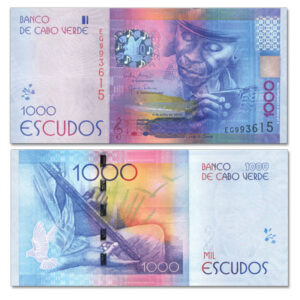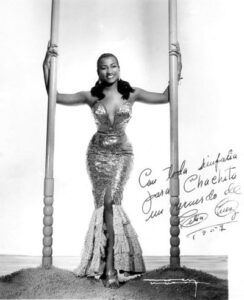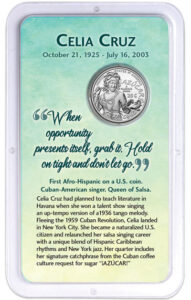Cruz, Coffee & a Quarter

Look at the bold design for the fourth coin in the 2024 U.S. Women Quarters series. Can you guess what trails famed salsa singer Celia Cruz blazed from roads she did not take?
Expected to teach high school English in Havana, she didn’t. Asked to acknowledge Cuban dictator Fidel Castro, she refused. In a music business dominated by men, she walked away as the singer for a dance band and became a solo artist.
To understand how this vocal dynamo transcended expectations to be honored on a U.S. quarter, let’s start with her ancestral roots.
Nature? Or, nurture?
Regarded as the most popular Latin artist of the 20th Century, Úrsula Hilaria Celia de la Caridad Cruz Alfonso was born in 1925 in a working-class neighborhood of Havana. Her father was a railroad worker of Spanish origin and her Haitian-born mother, the homemaker of their extended family.

Genealogical and genetic research discovered Celia descended from the Balanta, one of the largest ethnic groups found in the West African countries of Guinea, The Gambia and Cape Verde. This last note features a stunning engraving of the music and artistry credited to this small island nation.
“Given that the music, Cuban culture, so much of it owes its existence to West African and Central African cultures, I always see [the performance] as a return back to where this music, where our cultures, where our people came from,” observed David Garcia, a music professor at the University of North Carolina at Chapel Hill.
Garcia was commenting on Celia’s participation in the music festival billed as Zaire ’74. Held in the country known today as Democratic Republic of the Congo, the landmark event was a musical reunion between Africa and its diaspora. Along with Celia, it featured such leading black American entertainers as B.B. King, Bill Withers and James Brown alongside their African counterparts.
Spanish Roots
Following the lead of explorer Christopher Columbus, in 1502 Spanish colonizers brought the first slaves to the Caribbean from West Africa. Their farming know-how was put to work growing tobacco, coffee and sugar, regarded as the cash crops of world trade.

About 20 years later, Spain extended its empire into North America, colonizing Mexico and huge swaths from which states such as Florida and California would later be carved. Two descendants were honored on U.S. Women Quarters for their Latina activism – Texas journalist Jovita Idar and New Mexico suffragist Nina Otero-Warren. The Celia Cruz quarter represents the third woman of Spanish descendent so honored.
While not as overtly political as either woman, Celia never publicly acknowledged Fidel Castro – neither before nor after the Cuban Revolution. She was touring in Mexico with the popular Cuban dance band, La Sonora Matancera, when Castro finally gained total control of Cuba in the summer of 1960. Band director Rogelio Martinez reportedly said, “I don’t think we’re coming back.”
Indeed, they didn’t. When Celia’s mother died two years later and she asked permission to enter Cuba for the funeral, the Cuban embassy denied Celia a visa.
Naturalization
Moving to the New York City area where the Latin music scene was flourishing, Celia became a naturalized U.S. citizen in 1961. Four years later, with the help of husband-turned-manager and former band trumpeter Pedro Knight, Celia struck out on her own as a female solo artist – the first in America to sing salsa.
She signed with the music label, Fania Records. The vinyl albums it issued represented a meld of sounds from Latin America and the Caribbean, with African rhythms and American avant-garde jazz tempos. Fans consider this period the golden age of salsa and Celia its queen.

During her career, Celia Cruz recorded more than 70 albums and songs, many of which went gold or platinum. She was awarded the National Medal of the Arts in 1994. She won five Grammy Awards; her sixth was awarded after her death in 2003.
To many, Celia was ‘La Guarachera de Cuba’ – a singer who could handle fast lyrics and was good at improv. Her exuberant performances were a source of joy, according to eyewitness accounts. Designed and sculpted by the U.S. Mint’s Phebe Hemphill, the Celia Cruz quarter shows the larger-than-life entertainer whose vigorous vocals were heightened by lavish costumes, wigs and excessively high heels.
The quarter’s reverse is also punctuated with the exclamation: azucar! It’s the Spanish word for sugar, a near-requirement to drink the dark-roasted Cuban coffee that Celia frequently ordered. The sweet word also became her verbal insignia at performances, symbolizing her love for life, her heritage and her audiences.
But don’t take my word for it. In the sources listed below, you’ll discover a number of music videos. Give a listen and then share your comments below about this successful singer or the quarter that honors her groundbreaking achievements.
SOURCES:
“Celia Cruz: Cuban American Singer.” National Museum of African American History and Culture. https://nmaahc.si.edu/latinx/celia-cruz Accessed April 9, 2024.
Cid, Omer Pardillo. “Celia Cruz’s Manager on What Fidel Castro’s Death Would Mean to Her: Exclusive.” November 28, 2016. https://www.billboard.com/music/latin/celia-cruz-manager-omer-pardillo-cid-fidel-castro-7588938/ Accessed April 10, 2024. –As told to Leila Cobo
Germain, Jacquelyne. “The Enduring Legacy of Celia Cruz, the ‘Queen of Salsa’”. November 21, 2022. Smithsonian Magazine. https://www.smithsonianmag.com/smithsonian-institution/enduring-legacy-queen-salsa-celia-cruz-180981126/ Accessed April 10, 2024.
Gringlas, Sam & Shapiro, Ari. “Before The Rumble In The Jungle, Music Rang Out At Zaire 74.” All Things Considered. National Public Radio. June 14, 2017. https://www.npr.org/2017/06/14/532636128/before-the-rumble-in-the-jungle-music-rang-out-at-zaire-74 Accessed April 10, 2024.
Manuel, Peter. “The Soul of the Barrio: 30 Years of Salsa.” September 25, 2007. https://nacla.org/article/soul-barrio-30-years-salsa Accessed March 6, 2024.
Meminger, Dean. “Celebrating the legacy of Celia Cruz.” July 14, 2023. https://ny1.com/nyc/bronx/entertainment/2023/07/14/celebrating-the-legacy-of-celia-cruz, Accessed March 6, 2024
Pearlman, Ellen. “Azúcar! Celia: The Life and Music of Celia Cruz at the New World Theater.” March 2008. The Brooklyn Rail. https://brooklynrail.org/2008/03/music/azcar-celia-the-life-and-music-of-celia-cruz-at-the-new-world-theater Accessed March 6, 2024.
Román, Iván. “How Salsa Music Took Root in New York City.” October 14, 2022. https://www.history.com/news/salsa-music-origins-new-york-city-mambo-machito Accessed March 6, 2024.



